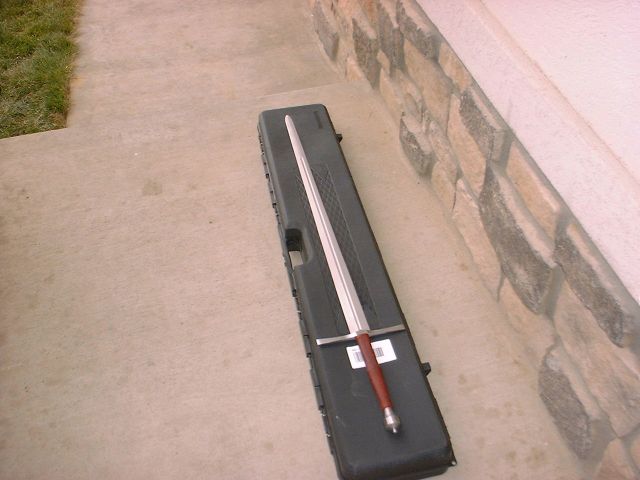Gus was kind enough to send a 1562 to the Rocky Mountain Historical Combat Guild for the purpose of testing, and after 45 days of playing with and swooning over her, this is my review.
The 1562 is an Oakeshott Type XIIa blade, but unlike the big warswords of the XIIIth century, she is a very handy longsword, more akin to a 15th or 16th century dueling weapon. The overall weight I came up with was 2lbs 13oz, which, for a sword of her size (just shy of 48”), makes for an extremely quick, effective sword. With a blade width of 1 13/16th’s at the cross and a nice tapering profile (1 3/8th’s at the CoP) she packs a wicked bite, and true to her subtype, still leaves you with a very serviceable point.
The sword arrived, neatly packed in one of Josh’s trademark rifle cases, with one of the new ecussoned 8” bow ties and a heavy scent stopper ala the 1548. The haft was wrapped in very supple black leather over 3 bands. The grip was very nice and straight, however, within a week the seam had begun to come apart. Gus and crew were very responsive, offering to fix it immediately (a really nice touch considering I hadn’t spent a dime on this baby!). However, since I have a little bit of experience at re-hilting swords, gained courtesy of Erik Stevenson, I unwrapped the grip the rest of the way, and decided to reshape the core and re-wrap it in deep blood-red leather. The picture below shows the finished product.
The new grip really sets off the hefty breadth of the blade at the cross, and adds a distinctive flair to an already superb blade.
The blade was finished in Gus’ standard workmanlike polish. Being a bit anal, one of the first things I always do with a new blade is to take varying degrees of wet/dry automotive sandpaper and a sanding block and do a wet-oil sand on the blade. Starting out with 180 grit and working up to 400 grit gives a very nice satin finish and really allows me to form a bond with a blade (ok maybe a bit existential, but I am strange like that). While sanding, it gives you a good chance to really get down and look at the way the blade is formed. This is where the Lady Carmen really shines (no pun intended). The fuller is laser straight and evenly spaced on both sides of the blade. The edges were a nice blended bevel, and extremely sharp. And the bevel itself showed a uniform blend up and down the length of the blade. The point was centered nicely and the edges have an equal curve to the point. The sword exhibits a gentle distal and profile taper, and while I have the measurements from my micrometer, I think it best to leave those undisclosed.
The sword was designed as a cutter, so a couple of the RMHCG’ers and myself got together on a Sunday afternoon to put her through her paces.
WE WERE NOT DISAPOINTED!
The 1562 tracks as naturally as you could want from a cutting blade. The combination of long 8” hilt and long 37” blade make the weapon get up to a frighteningly quick terminal velocity, and the edge’s simply take no notice of plastics. Even the thicker plastic that windshield washer fluid comes in was cleft asunder with laser like precision. Whether we did kenjutsu style cuts (courtesy of Tom) or more traditional Mesiterhau the sword absolutely destroyed the jugs we put up on the cutting stand. The best pickle chipping effort of the day belonged to Tom Lux, he managed to get seven neat slices out of one milk jug. Even the little 20oz water bottles were able to withstand at least 2 cuts, instead of being launched across the yard, as is their usual wont. Noteworthy also, was the swords ability to track true in the thrust. While not the forte of this style of blade, the lady Carmen was nonetheless a very able thruster and the point had a natural flow into whatever you pointed her at. One last point I would like to make about the Lady Carmen, is the absolute lack of noticeable vibration or shock transmitted through the grip in the process of cutting. Even when we botched a rising cut (unterhau) and thunked her into the 4x4 cedar post holding our test cutting medium, she was able to shear through and still cleanly cut through our milk jugs, with no deformation of the cutting edge whatsoever!
All in all, this is simply a superb blade! She has the mass and heft to make even neophyte swordsmen look good, and for those with at least a modicum of training, it is an absolutely viscous sword. I do not hesitate to recommend this sword to anyone interested in a reasonably priced, high quality cutting blade. It IS that good. The only nitpick I have is that as good as she is currently, I think she would be that much better with a 38”+ blade, a 9” hilt and a more acute point. I would like to end with a sincere thanks from all in the Rocky Mountain Historical Combat Guild to Gus and Josh both for giving us the opportunity to test and play with this fine blade. And to Norman E. Kidd, Tom Lux and our neophyte friend Bryce Tatman for helping put her through her paces.
PS Norm-You owe a 6 pack for the hilt work-JKB
Stats
Sword Make and Model: Angus Trim Lady Carmen
Oakeshott Typology: XIIa
Pommel: Heavy Scent Stopper
Handle: Three band black leather, 8”
Cross Guard: Ecussoned 8” Bow Tie
Sword Weight: 45.4 Oz.
Sword Length Overall: 47 13/16th’s
Blade Length: 37”
Point of Balance: 5 ¾” from Cross
Center of Percussion: ~24 ¾ ‘ from Cross
Blade Width at Cross: 1 13/16th’s inches.
Blade Width at CoP: 1 3/8th inches.

